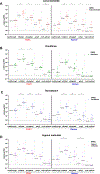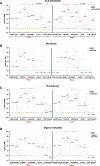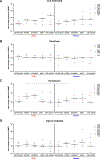Mechanistic differences underlying HIV latency in the gut and blood contribute to differential responses to latency-reversing agents
- PMID: 32910065
- PMCID: PMC7990078
- DOI: 10.1097/QAD.0000000000002684
Mechanistic differences underlying HIV latency in the gut and blood contribute to differential responses to latency-reversing agents
Abstract
Objective: While latently HIV-infected cells have been described in the blood, it is unclear whether a similar inducible reservoir exists in the gut, where most HIV-infected cells reside. Tissue-specific environments may contribute to differences in the mechanisms that govern latent HIV infection and amenability to reactivation. We sought to determine whether HIV-infected cells from the blood and gut differ in their responses to T-cell activation and mechanistically distinct latency reversing agents (LRAs).
Design: Cross sectional study using samples from HIV-infected individuals (n = 11).
Methods: Matched peripheral blood mononuclear cells (PBMC) and dissociated total cells from rectum ± ileum were treated ex vivo for 24 h with anti-CD3/CD28 or LRAs in the presence of antiretrovirals. HIV DNA and 'read-through', initiated, 5' elongated, completed, and multiply-spliced HIV transcripts were quantified using droplet digital PCR.
Results: T-cell activation increased levels of all HIV transcripts in PBMC and gut cells, and was the only treatment that increased multiply-spliced HIV RNA. Disulfiram increased initiated HIV transcripts in PBMC but not gut cells, while ingenol mebutate increased HIV transcription more in gut cells. Romidepsin increased HIV transcription in PBMC and gut cells, but the increase in transcription initiation was greater in PBMC.
Conclusion: The gut harbors HIV-infected cells in a latent-like state that can be reversed by T-cell activation involving CD3/CD28 signaling. Histone deacetylation and protein kinase B may contribute less to HIV transcriptional initiation in the gut, whereas protein kinase C may contribute more. New LRAs or combinations are needed to induce multiply-spliced HIV and should be tested on both blood and gut.
Conflict of interest statement
Figures





Similar articles
-
Gut and blood differ in constitutive blocks to HIV transcription, suggesting tissue-specific differences in the mechanisms that govern HIV latency.PLoS Pathog. 2018 Nov 15;14(11):e1007357. doi: 10.1371/journal.ppat.1007357. eCollection 2018 Nov. PLoS Pathog. 2018. PMID: 30440043 Free PMC article.
-
High-throughput Characterization of HIV-1 Reservoir Reactivation Using a Single-Cell-in-Droplet PCR Assay.EBioMedicine. 2017 Jun;20:217-229. doi: 10.1016/j.ebiom.2017.05.006. Epub 2017 May 4. EBioMedicine. 2017. PMID: 28529033 Free PMC article.
-
Ex Vivo Bioactivity and HIV-1 Latency Reversal by Ingenol Dibenzoate and Panobinostat in Resting CD4(+) T Cells from Aviremic Patients.Antimicrob Agents Chemother. 2015 Oct;59(10):5984-91. doi: 10.1128/AAC.01077-15. Epub 2015 Jul 13. Antimicrob Agents Chemother. 2015. PMID: 26169416 Free PMC article.
-
Shocking HIV out of hiding: where are we with clinical trials of latency reversing agents?Curr Opin HIV AIDS. 2016 Jul;11(4):394-401. doi: 10.1097/COH.0000000000000279. Curr Opin HIV AIDS. 2016. PMID: 26974532 Review.
-
Underlying mechanisms of HIV-1 latency.Virus Genes. 2017 Jun;53(3):329-339. doi: 10.1007/s11262-017-1443-1. Epub 2017 Mar 3. Virus Genes. 2017. PMID: 28258391 Review.
Cited by
-
The Persistence of HIV Diversity, Transcription, and Nef Protein in Kaposi's Sarcoma Tumors during Antiretroviral Therapy.Viruses. 2022 Dec 13;14(12):2774. doi: 10.3390/v14122774. Viruses. 2022. PMID: 36560778 Free PMC article.
-
Ethnobotanical survey and phytochemistry of medicinal plants used in the management of HIV/AIDS in Eastern Uganda.Heliyon. 2024 May 24;10(11):e31908. doi: 10.1016/j.heliyon.2024.e31908. eCollection 2024 Jun 15. Heliyon. 2024. PMID: 38845918 Free PMC article.
-
Intestinal endothelial cells increase HIV infection and latency in resting and activated CD4 + T cells, particularly affecting CCR6 + CD4 + T cells.Retrovirology. 2023 May 18;20(1):7. doi: 10.1186/s12977-023-00621-y. Retrovirology. 2023. PMID: 37202790 Free PMC article.
-
Blockade of TGF-β signaling reactivates HIV-1/SIV reservoirs and immune responses in vivo.JCI Insight. 2022 Nov 8;7(21):e162290. doi: 10.1172/jci.insight.162290. JCI Insight. 2022. PMID: 36125890 Free PMC article.
-
Multiply spliced HIV RNA is a predictive measure of virus production ex vivo and in vivo following reversal of HIV latency.EBioMedicine. 2021 Mar;65:103241. doi: 10.1016/j.ebiom.2021.103241. Epub 2021 Feb 26. EBioMedicine. 2021. PMID: 33647768 Free PMC article.
References
-
- Wong JK, Hezareh M, Gunthard HF, Havlir DV, Ignacio CC, Spina CA, et al. Recovery of replication-competent HIV despite prolonged suppression of plasma viremia. Science 1997; 278(5341):1291–1295. - PubMed
-
- Finzi D, Hermankova M, Pierson T, Carruth LM, Buck C, Chaisson RE, et al. Identification of a reservoir for HIV-1 in patients on highly active antiretroviral therapy. Science 1997; 278(5341):1295–1300. - PubMed

